In October we joined the Professional Horticulture Group South West for a visit to Mapperton Gardens near Bridport, in Dorset and later this month on 27 November the Group will be holding its annual Christmas celebration at Lackham College which will include a talk by Nick Morgan MHort (RHS), Senior Superintendent at RHS Garden Wisley on 'The Development and Management of the Wisley Glasshouse Unit'. Afterwards there will be a tree planting in memory of Oliver Menhinick, a former lecturer at the college who died during the group's visit to Cornwall earlier this year.
In November SCI will be holding its annual Members' Forum on 19 November. Owing to the refurbishment at Belgrave Square this will be held at the Royal College of Surgeons in Lincoln's Inn Fields. The group has been heavily involved in the MAC Communications working party, which will be reporting on its views on SCI social media during the morning session.
Editor
Weeds in Onion and Brassica Crops
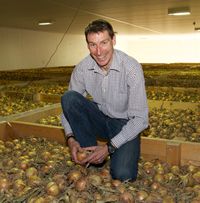
Although Andy advises on all aspect of the culture of these two crop groups his special interest is weed control. This is becoming difficult as more and more chemicals are withdrawn as a result of ever more stringent regulations for approval. As usual horticultural crops cover too small an area to justify these approval costs so the industry has to make use of chemicals approved for the major crops. One of the consequences is the withdrawal of familiar selective and residual herbicides.
While brassica growers are used to mechanically weeding between rows this is less common in onion and leek crops. Between row weeding might be a challenge but it gets a lot worse when one comes to in-row weeding. One solution, produced by Garford Farm Machinery uses video image analysis techniques to identify the crop and guide mechanical 'hoes' that move quickly across the row as the machinery is drawn down the row.
An HDC project has taken this a step further and in conjunction with Tillett and Hague Technology they have been investigating using a combination of factors including plant size, shape, height, and position relative to crop rows to identify weeds. Height was eliminated in the end as the optimum camera angle for the other factors was too steep to measure height accurately.
The weeds are killed with a pulse of herbicide but again this presents challenges. Most spray nozzles have too wide an angle to start with. However the biggest challenge was delivering a micro-pulse of spray (down to 30ms duration) with no residual drips. This system has proved effective at controlling volunteer potatoes in crops. There is inevitably some crop damage although the levels are regarded as 'acceptable' by the growers involved.
The system is now being developed further to enable it to identify a broader range of weeds. However, the end result could be an expensive piece of machinery with only a narrow window when it can be used. This could make it too expensive for individual growers and more appropriate for contract operation.
Andy also described some of the pest and disease issues. Here again the shortage of approved chemicals has forced growers to look carefully at biological controls. While these have proved effective within the glasshouse environment, open fields present additional challenges. When eating brassicas, consumers find the presence of all 'life', however beneficial, equally undesirable.
Plant of the Month
Liriodendron tulipifera, tulip tree, Magnoliaceae
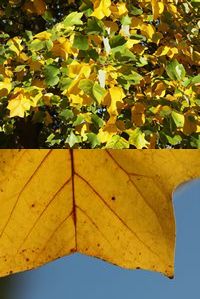
This tall tree native to eastern North America, was so useful as a timber tree that large tracts of forest have been felled although in places patches of old growth forest do remain. This is the tallest tree of the eastern part of North America - the giant redwood of the east coast! Its timber uses are many and varied. The American Indians used these trees to make canoes, and the white settlers used them to make cigar and Bible boxes. Other uses include roof shingles, clapboards and cabinet making.
In early summer (June and July) look more closely at this tree to see why it has the common name of tulip tree. The flowers, which do resemble tulips superficially, are green-yellow with orange coloured bands at the base of the petals. At this time of the year, on mature trees, you may find the fruits which consist of lots of individual swollen carpels, joined at their bases and you will see the similarity in structure to Magnolia fruits.
There is only one other species of Liriodendron and that species
grows in China - Liriodendron chinense. This species was only
discovered at the very beginning of the 20th century and introduced to 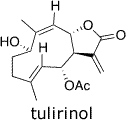
The tulip tree has been found to contain a lactone insect antifeedant against the gypsy moth larvae. This substance named tulirinol, is a sesquiterpene and has an unusual structure.
Alison Foster
Oxford Botanic
Garden
Medicinal Plant of the Month
Cephalotaxus haringtonii, plum yew, Cephalotaxaceae
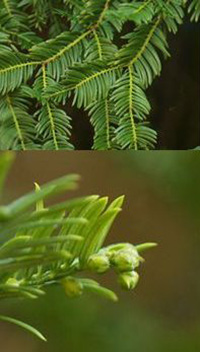
The parent molecule, cephalotaxine, has no anti- leukaemia activity but harringtonine (HT) and homoharringtonine (HHT), which are both esters of cephalotaxine, do. Clinical trials of HHT were carried out in the 1970s in China using a mixture of HT and HHT. Although both substances had similar activity, HHT was chosen for further development because a higher yield could be obtained by extraction from its source. Clinical development was halted due to the introduction of imatinib mesylate (Gleevec) by Novartis, which was hailed at the time as a 'magic bullet' to cure cancer.
However, more recently, clinical investigators have had success treating patients with chronic myelogenous leukaemia with HHT who have failed imatinib therapy. The HHT is made semi-synthetically from cephalotaxine which is extracted from the leaves of Cephalotaxus harringtonii and is 70-fold more abundant than HHT. HHT has a novel mode of action, working by inhibiting the early stages of protein synthesis of some short-lived proteins that are only present in leukaemia cells. The Australian company, Chemgenex, is also investigating the use of this drug for the treatment of other forms of leukaemia, solid tumours and other diseases of the blood and bone marrow.
Cephalotaxus is like a large-leaved yew, but differs in that the leaves have two broad silvery bands on the underneath side. It can also be distinguished from the fairly similar Torreya by the non-spine-tipped leaves.
Alison Foster
Oxford Botanic
Garden
News from our Associates
Commercial Horticultural Association

It will be taking a group to the new International Horticultural Trade Fair at the beginning of November and have started recruiting for IPM Essen (28-31 Jan), Fruit Logistica (5-7 Feb). Later in 2014 it will be taking groups of exporters to HortiTech Amsterdam, the Naivasha Horticultural Fair in Kenya and Growtech Eurasia in Turkey. For details of any of these events visit the CHAwebsite.
International Society for Horticultural Science
ISHS is preparing for its 29th International Horticultural Congress in Brisbane
next August. The theme of next year's congress will be Horticultural Education,
Research Training and Extension in Changing Times and our Committee member
and ISHS representative Professor Geoffrey Dixon will be one of the Keynote
speakers who will speak on 'Making 21st Century European Horticultural Knowledge
Transfer Fit-for-Purpose'.
Horticulture Industry News
For the very latest horticultural news follow us on Facebook,
Twitter, or
LinkedIn
Elevated
CO2 - the good and the bad
An article in the October issue of SCI Journal of the Science
of Food and Agriculture - scientists show that elevated
CO2 increases
the yield of carrot, radish and turnip by up to 140%. However, protein, vitamin
C and fat contents decreased significantly for all the vegetables while sugar
and fibre contents were increased. The response of the vegetables to elevated
CO2, in terms of elemental composition, was different with a significant decrease
in many important minerals. Elevated
CO2 decreased
the amount of most fatty acids and
amino acids in these vegetables. More
The increasing importance of herbicides in worldwide crop production
A review article in Pesticide Science describes how herbicide use is increasingly
being adopted around the world as many developing countries are facing shortages
of workers to hand weed fields as millions of people move from rural to urban
areas. In these countries, herbicides are far cheaper and more readily available
than labour for hand weeding. History shows that in industrialising countries in the past, the same phenomenon occurred - as workers have
left agriculture, herbicides have been adopted.
It is inevitable that herbicide use will increase in sub-Saharan Africa, not only because millions of people are leaving rural areas, creating shortages of hand weeders, but also because of the need to increase crop yields. Hand weeding has never been a very efficient method of weed control - often performed too late and too infrequently. Uncontrolled weeds have been a major cause of low crop yields in sub-Saharan Africa for a long time. In many parts of the world, herbicides are being increasingly used to replace tillage in order to improve environmental conditions. In comparison with tillage, herbicide use reduces erosion, fuel use, greenhouse gas emissions and nutrient run-off and conserves water. More
Arabidopsis has sold science a dummy
Scientists have misunderstood one of the most fundamental processes in the
life of plants because they have been looking at the wrong plant. Arabidopsis thaliana has become the dominant model plant in genetics
research because of its simple genetics and ease of use in a research environment.
Thousands of trays of the humble weed are cultivated in laboratories across
the world, but it turns out they may actually contain a rather oddball plant.
Researchers found that Arabidopsis thaliana was exceptional in not having a key 'censorship' protein called SMG1. SMG1 was known to play a vital role in the growth of animals as multicellular organisms, but scientists thought that plants built their complex life fundamentally differently. That conclusion, it turns out, was built on a dummy sold by Arabidopsis thaliana. Everybody thought that this protein was only in animals. They thought that because, basically, most of the world studies one plant: Arabidopsis thaliana. More
There's gold in them there... gums
Scientists in Australia's have proved that the leaves of certain eucalyptus
trees contain minute amounts of the precious metal that have been naturally
absorbed. Eucalypts in the Kalgoorlie region of Western Australia and the
Eyre Peninsula in South Australia are drawing up water containing gold particles
from the earth via their roots and depositing it in their leaves and branches.
Some eucalyptus root systems dive down deeper than 30m, through much of the sediment that sits on top of solid ore-bearing rock. The tree acts as a hydraulic pump drawing up water containing the gold. As the gold is likely to be toxic to the plant, it is moved to the leaves and branches where it can be released or shed to the ground. This can now be used as a means of gold prospecting - where there is gold in the gum trees, there is ore deep down. More
Maths study could help in developing new super-crops
Around 3% of all plants use an advanced form of photosynthesis
(C4), which allows them to capture more carbon dioxide, use less water, and
grow more rapidly. Overall this makes them over 50% more efficient than plants
that use the less efficient form. A new study has traced back the evolutionary
paths of all the plants that use advanced photosynthesis, including maize,
sugar cane and millet, to find out how they evolved the same ability independently,
despite not being directly related to one another.
Using mathematical analysis,
researchers uncovered a number of tiny changes in the plants' physiology that,
when combined, allow them to grow more quickly; using a third as much water
as other plants; and capture around thirteen times more carbon dioxide from
the atmosphere. Together, these individual evolutionary advances make up a
'recipe' that could be used to improve key agricultural crops that only use
the less efficient form. The study's authors say this knowledge could be used
to breed super-crops such as faster-growing, drought-resistant rice.
Can conservation kill?
Recent work shows that some plants in a biodiversity hotspot are under threat
from a common conservation practice, as well as development of surrounding
regions. Plants need phosphorus for growth. It's a big component of
many fertilisers. So for somewhere like phosphorus-poor soils in southwest
Australia, you'd expect an increase in phosphorus to be good news. In
fact it's not.
There are a couple of problems. One is that to survive in phosphorus-poor soils plants need special skills. There are plenty of adaptations they can make to live in low phosphorus soils, but these have costs. They wouldn't be able to compete against other plants in soils with more phosphorus, which is just one reason why many plants found in these soils are rare. Another is that some plants have no self control. If they live in a place where phosphorus is limited, they'll want to grab all that they can. If there's a boom in phosphorus, that ability to grab it becomes a glut and they're in deep trouble.
Research shows that one of the most interesting feature of the southwest Australian plants isn't simply that they live in low-phosphorus soils. It's also that they do it alone without the help of mycorrhizal partners. More
Prairie fruit potential unearthed
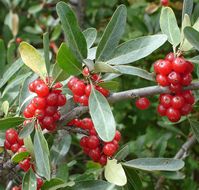
Buffaloberry was four times as high in ascorbic acid as oranges. Chokecherry contained high levels of anthocyanin pigments (anti-oxidants), and can be considered a good source of these compounds with a higher concentration than fruits such as cranberry. Anthocyanin's purported health benefits include anti-inflammatory properties, cardio-vascular benefits and potential anticarcinogenic properties. Sea buckthorn contained high levels of lipids for a fruit, though the level varies with location and variety. All of the fruits contained high levels of fibre. More
Stress linked to bee colony failure
Extended periods of stress can cause bee colony failures. Scientists have
found that when bees are exposed to low levels of neonicotinoid pesticides
- which do not directly kill bees - their behaviour changes and
they stop working properly for their colonies. The results showed that exposure
to pesticides at levels bees encounter in the field, has subtle impacts on
individual bees, and can eventually make colonies fail. This discovery provides
an important breakthrough in identifying the reasons for the recent global
decline of bees, a trend that has baffled many experts worldwide.
£500m food export action plan unveiled
Up to 1,000 British food and drink firms are in line to benefit from a new
exports action plan, which aims to deliver a £500 million boost to the
UK. Over the last year, the UK government's food and drink industry, UK Trade
& Investment (UKTI), and the Department for Environment Food & Rural
Affairs (Defra), have been developing an 'Action Plan' to grow exports for
the UK agri-food and drink sector.
The aim is to deliver improvements in promotion, trade development, market unlocking, and simplifying support and trade procedures for industry. The plan is designed to deliver in six key areas: promoting UK food and drink internationally; helping UK firms win business internationally through targeted campaigns; unlocking market barriers and simplifying the paperwork; encouraging more companies, particularly SMEs, to explore exporting; promoting inward investment; and enhancing dialogue between government and industry. More
Twenty points of broad scientific consensus on GE crops:
1. GE crops currently on the market are safe to eat. (See the European Commission
Joint Research Centre, European Food Safety Authority, The American Medical
Association, the National Academy of Sciences, and the World Health Organization)
2. The processes of genetic engineering and conventional genetic modification
pose similar risks of unintended consequences.
3. The risks and benefits of new traits in crops depend upon the traits themselves
and not the means of their introduction, whether through GE or conventional
means.
4. The planting of Bt cotton has reduced the use of sprayed insecticides.
5. The planting of Bt corn in the US has benefited growers of non-GE corn.
6. Planting of Bt cotton has enhanced yields in China and India.
7. Planting of Bt cotton has reduced insecticide poisonings of farmers and
their families.
8. Adoption of Bt cotton enhances insect biodiversity.
9. If not properly managed, overuse of Bt spray or Bt crops will lead to Bt
resistant insects.
10. Farmers need to deploy a crop diversity strategy and crop rotation to
reduce the evolution of insect resistance.
11. US farmers that plant BT crops are required to deploy a 'refuge
strategy': creating refuges of crop plants that do not make Bt toxins.
This promotes survival of susceptible insects and has helped to delay evolution
of pest resistance to Bt crops.
12. Global pest-monitoring data suggest that Bt crops have remained effective
against most pests for more than a decade.
13. Failure to provide adequate refuges appears to have hastened resistance
of pink bollworm in India and western corn rootworm in the US to Bt.
14. Effective methods for slowing the spread of insect resistance include
crop rotation, intercropping and planting refuges of non-BT cotton and non-crop
species.
15. Planting of herbicide tolerant (HT) crops has reduced the environmental
impact of herbicide use. This is because the reduced tillage associated with
planting of HT crops has led to reduced soil erosion and reduced greenhouse
gas emissions.
16. The liberal use of glyphosate without proper management has spurred the
evolution of weeds resistant to that herbicide.
17. The evolution of herbicide resistant weeds is a problem for farmers who
rely on a single herbicide.
18. GE crops are just one of the many tools that can be used to enhance the
sustainability of farms.
19. Papaya genetically engineered for resistance to papaya ringspot virus
has protected yields against significant losses from the virus and saved the
Hawaiian papaya industry.
20. Consumption of Golden Rice, within the normal diet of rice-dependent poor
populations, could provide sufficient vitamin A to substantially reduce the
6,000 deaths caused every day by vitamin A deficiency and save the sight of
several hundred thousand people per year in a cost efficient manner. More
Fungus Versus Plant
The relationship between pathogens and their hosts is a never-ending, continuously
evolving battle. Scientists have now discovered that one plant pathogen even
hijacks its host's defence system for its own use. According to a report
the grey mould fungus, Botrytis cinerea, deploys small, non-coding RNAs (sRNAs)
that subvert the plant's silencing machinery, forcing it to suppress
the expression of host immune system genes. More and More
ECPA points to declining research
Research and development for new crop protection products needed by European
farmers is in decline, according to a new analysis of market trends in the
EU and around the world. The study revealed that the number of active ingredients
being developed and introduced to the EU is steadily decreasing - even
as global expenditure on agricultural R&D is on the rise. The share of
global crop protection R&D focused on European markets has decreased from
33% in the 1980s to only 16% today, the report highlighted.
Moreover, the European market's share of total worldwide R&D expenditure
for new product development in agricultural life sciences is just 7.7% today compared to 33% in the 1980s. More
Why don't trees 'bleed' to death when they are injured?
Researchers have discovered how 'check valves' in wood cells control
sap flow and protect trees when they are injured. The study used a special
microscope to reveal how nanostructures help contain damage within microscopic
cavities called bordered pits in wood-fibre cells. The pits allow sap to circulate
through adjacent cells. Using a powerful new type of confocal, laser-scanning
microscope, the 4Pi, the scientists discovered that the bordered pits are
filled with a mesh membrane of nanofibrils, which radiate from a thickened,
solid central region called the torus - like a bull's eye in a target.
Fluids ooze in, through the mesh-like membrane, around the torus, and out the other side. When wood is injured, such as by an insect, the torus and part of the membrane will typically shift from the centre of the pit to one side to seal the pit opening. Using specific chemical tags to dye the pectin red and cellulose green, they saw that pectin surrounds the torus and forms ring-like structures at its margin. As part of the pit-sealing process, pectin separates to form an outer fringe around the torus, while the bulk of the pectin gets pulled into the aperture to block it. More
Peat usage down
According to the findings of a research project, peat use across both amateur
and professional markets fell between 2011 and 2012. In addition the proportion
of volume supplied that is accounted for by peat also fell across both markets.
Between 2011 and 2012 the volume of growing media sold by manufacturers in
the UK (including export sales) fell by 12%. Volumes for professional use
fell by 7% and those for amateur use fell by 14%.
Across all sectors of the growing media market the proportion of volume accounted for by peat and composted green waste fell, while the proportion of ingredients such as bark, coir and wood based ingredients increased. For amateur use, peat accounted for 58% of volume sold into retailers in 2011 compared with 52% in 2012. For professional use, peat accounted for 72% of volume sold compared with 69% in 2012.
Legionella 'common' in compost brands
Legionella bacteria appears to be 'common' in many compost brands
sold in the UK, a study has found. A team from Strathclyde University in Glasgow
tested 22 different brands of compost and found that 14 contained a variety
of Legionella species. It says a larger survey is needed to determine the
extent of the issue.
Disease-causing micro-organisms are widespread in the environment, and therefore it is not too surprising that species of Legionella that can cause human disease are present in compost. Any environment where you have pathogenic bacteria could be a source of infection, and we already know that compost has been linked to human Legionella infection in countries such as Australia and New Zealand. More
Biggest Gene Thief
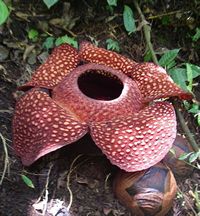
Plant genomes seem to be especially rife in genes acquired by HGT, and this is particularly true for the parasitic kinds, of which the Rafflesias are impressive examples. It appears they are not just effective parasites, but also genomic thieves. More
Plant immune response to pathogens differs with changing temperatures
Temperature fluctuation is a key determinant for microbial invasion and host
evasion. It is now reported that ambient temperature changes lead to pronounced
shifts of two distinct plant immune responses: pattern-triggered immunity
(PTI) and effector-triggered immunity (ETI). Plants preferentially activate
ETI signalling at relatively low temperatures (10-23°C), whereas
they switch to PTI signalling at moderately elevated temperatures (23-32°C). More
Events Calendar
Fruit Culture and its
Traditional Knowledge along Silk Road Countries
4 - 8 Nov, International Society for Horticultural Science
Tbilisi, Georgia
Fruits
and Roots: A Celebration and Forward Look
6 - 7 Nov, Association of Applied Biologists
East Malling, UK
Plant Breeding Congress
10 - 14 Nov
Antalya, Turkey
30
Years of Plant Biotechnology
12 Nov, VIB
Kouter, Belgium
GroSouth
13 Nov, Roundstone Nurseries
Chichester, UK
BCPC
Weed Review
14 Nov, British Crop Production Council
Rothamsted, UK
Pests
and Natural Enemies in Fruit Crops
14 Nov, Royal Entomological Society and East Malling Research
East Malling, UK
Bacterial Canker of
Kiwifruit
19 - 22 Nov, International Society for Horticultural Science
Mt Maunganui, New Zealand
Onion
& Carrot Conference & Exhibition
20 - 21 Nov
Peterborough, UK
Farm Business
Innovation
28 - 29 Nov, Prysm Media
London, UK
Positive
Plant Microbial Interactions: Their role in maintaining sustainable and
natural ecosystems
2 - 3 Dec, Association of Applied Biologists
Brigg, UK
Plant
Genomes & Biotechnology: From Genes to Networks
4 Dec, Cold Spring Harbor Laboratory
Cold Spring Harbor, USA
Quality Management
in Postharvest Systems
4 - 7 Dec, International Society for Horticultural Science
Vientiane, Laos
Advances
in Nematology
10 Dec, Association of Applied Biologists
London, UK
Photo-Physiology Phenotyping
Workshop
16 - 17 Dec, University of Essex
Colchester, UK
Rethinking
Agricultural Systems in the UK
18 - 19 Dec, Association of Applied Biologists
Oxford, UK
International
Advances in Pesticide Application
8 - 10 Jan, Association of Applied Biologists
Oxford, UK
Synthetic
Biology
8 - 10 Jan, Society of Experimental Biology
London, UK
Brassica
Growers' Conference and Trade Exhibition
21 Jan, Brassica Growers Association
Grange-de-Lings, UK
Impact
of Pesticides on Bee Health
22 - 24 Jan, SEB, SB, BES.
London, UK
If you would like to advertise a forthcoming event please contact. ester.monfort@soci.org
Horticulture Group Contact Details
For submitting ideas or to volunteer to be part of a committee or a group, please contact:
Chairman - Peter Grimbly
Meetings Secretary - Alison Foster
Minutes Secretary - Margaret Waddy
Newsletter co-ordinator - Sue Grimbly scihortigroup@btinternet.com
Group Contact - Ester Monfort Martinez, E: ester.monfort@soci.org T: +44(0)20 7598 1584

